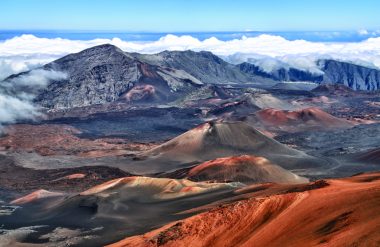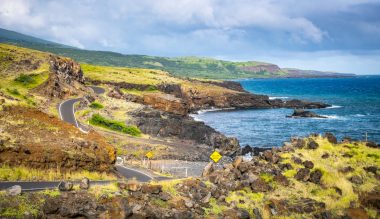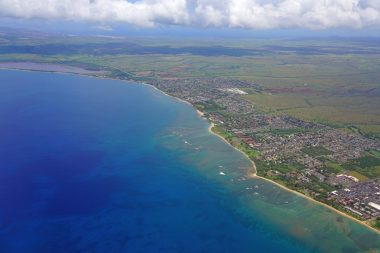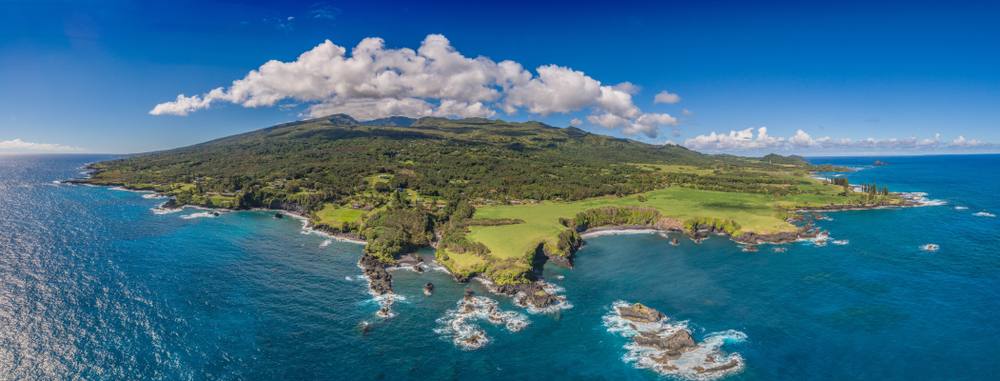Aloha is what the Hawaiians say. The island of Maui, where the inhabitants openly show their pride in their homeland, is nicknamed “The Magic Island” or the “Valley Island”. The credo is “Maui is the best”. This island is rich in beautiful beaches, sleepy villages and luxury hotels. Maui offers something for everyone.
Maui is the second largest of the Hawaiian islands and was named after the demigod Maui. There are flat land bridges between Mauna Kahamawai and Haleakala, which is why Maui is also called the valley island.
The History of Maui
Legend has it that the demigod Maui lifted the islands out of the sea, caught the sun with a lasso, and placed both on Haleakala. At the beginning of the 15th century, King Piilani ruled over the kingdom and united the island. At the end of the 18th century, victory over the last king was achieved and Maui became the capital of Hawaii. The island played a major role in whaling and had its heyday from 1840 to 1865. During the 1820s, the sugar industry emerged. It has been of great importance for whaling and has reached its peak: immigrants from numerous countries settled here, which shape the image of the island today.
Lahaina, the capital of Maui, was once a whaling town. There are some bars, restaurants, boutiques, shops and galleries. Whether you are looking for peace and quiet in remote nature or the hustle and bustle of people, there are both. Maui also offers plenty of sports activities on land and water.
The island, which covers around 1,883 square kilometres, offers many discoveries for adventure seekers. The simple life is just as present here as luxury. The West Coast boasts world-class resort hotels, which is particularly convenient for people who want to be pampered on vacation. There are some golf courses created by famous golfers. The east coast, on the other hand, is largely undeveloped and undeveloped. There is a lot of nature, quiet beaches and waterfalls. Hana, a small picturesque village, is worth a visit, because time seems to be irrelevant there.
Geographical location and climate of Maui
Maui, the second largest of Hawaii’s 8 main islands, is home to almost 120,000 inhabitants. The climate is tropical and quite pleasant. The average annual temperatures are 23 and 29 °C. Frequent trade winds often drive the rain to the north coast. Less rain falls on the south coast.
In the period between April and October, there is little rain and temperatures range from 23 to 30 °C. The water temperature of the Pacific Ocean is about 27 °C and offers swimming, diving and surfing fun.
The valley region of Maui connects the two volcanoes on the island, Haleakala and Puu Kukui. The topography is interspersed with flat plains in the interior of the island and volcanic mountains.
At higher altitudes of more than 900 m, temperatures are cooler and the climate is drier than on the coasts. The weather is often changeable due to the topography of the island. On Mount Haleakala alone, there are 7 different climate zones.
Sights on Maui
Haleakala Crater

Haleakala Crater is the top of the inactive East Maui volcano and rises 3,055 m into the air. The volcano peak offers a great view of the setting sun, which is a breathtaking experience for many people. If you want to explore this volcano, it is better to plan a full day.
Kaanapali
Kaanapali is a sandy beach with a length of 4.8 kilometers that is located in western Maui. This region is steeped in history and culture. Here is a black rock called Puu Kekaa, which is a sacred place in Hawaiian mythology. The souls of deceased people enter the spiritual world from the solid world. In the south of Kaanapali there is the whaling village and a market square with restaurants and shops. From this beach, the sugar cane train runs to Lahaina and offers a beautiful view of the route.
Hana Highway

The well-known road is 88 kilometers long and is a real attraction. It is quite narrow in places and has 54 bridges that are single-lane and there are more than 600 curves that should not be underestimated. But the adventure is worth it because the landscape is wonderful. On the route you will encounter waterfalls, bamboo forests, cliffs and white beaches. Flowers, tropical fruit plants and a black sand beach also appear. The road leads to the small village of Hana, where there are great sandy beaches, historic buildings and much more. It is worth spending the rest of the day here and visiting the cultural center of the city as well as the Hana Ranch.
Molokini
Molokini is a small island off the south coast of Maui that is shaped like a crescent. The island is a half-submerged volcano that has been inactive for ages. Molokini is a very attractive destination for divers. There are numerous fish in bright colors and a breathtaking underwater world. The island has been declared a nature reserve and whales can be watched in winter.
Maui Ocean Center
The Maui Ocean Center is worthwhile if you want to learn more about the underwater landscapes of Hawaii and the fish species that live here. There is a large aquarium with a volume of 2.839059 liters, which contains thousands of fish. The giant pool is particularly interesting for children, because here they see many interesting creatures, such as stingrays, turtles and starfish.
Maui is a real surfer’s paradise
Maui is ideal for surfers and windsurfers. There are many places where these sports can be practiced. In the north of Maui are the surfing areas of Lanes, Jaws and Spreckelsville, where windsurfing is allowed from 11:00 in the morning. The previous time belongs to the anglers, divers and swimmers.
On the Road to Hana route, you will discover the diversity of Maui. If you drive along the 103.6 Waikamoi Falls with great swimming ponds or the Twin Falls are on the route and the Waianapanapa and Wailua valleys also offer a lot of nature.
Haleakala National Park
The national park is divided into two sections, the Kipahulu and the Hawaii Volcanois. It was opened in 1916. Numerous hiking trails lead through the volcanic crater. They also own tent sites and accommodation. The view of sunrise and sunset is unique. After a 15-minute drive on the Road to Hana, you will reach Kipahulu. From the visitor center, it’s about an hour’s walk to Waimoku Falls, which is 100 meters high. There are opportunities to cool off in the ponds next door.
ʻĪao Valley
This valley is located 5 kilometers from Wailuku. It goes through a jungle and past a stream. There is a great viewpoint there that offers a fantastic view over Maui.
Sugar cane city of Pāʻia
The former sugar cane city of Pāʻia is a popular area for surfers because there is always a good breeze here. Divers can check out the Spartan Reef.
Beaches and Coasts of Maui

The coast of Māʻalaea Bay is populated by many thousands of visitors every year who enjoy the great beaches and warm water temperatures.
Kihei is a beach where you can enjoy the sound of the sea and relax from everyday life. The landscape is idyllic and ensures good relaxation.
If you are not a risk taker and don’t want to notice much of the rain, it is better to choose accommodation in southern Maui, for example in Wailea. There is the least rainfall and there are fantastic coasts and beaches that are worthwhile.
Why is Maui so unique?
Maui is an ideal destination for people who are adventurous and offers a lot of variety. Nature lovers will find their happiness here just as much as luxury lovers. The top hotels offer massages for relaxation and then you can go on a hike, for example to the Haleakala. In the evening, you can enjoy a delicious meal. Maui is for people who want it all


